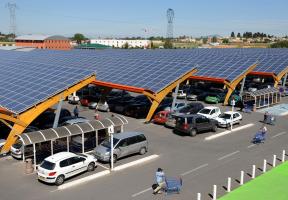The Worldwide Boom of Electric Vehicles
10 min read
Electric vehicles are fast gaining ground worldwide, mainly in China, Europe and the United States. A crucial transition for reducing greenhouse gas emissions. World energy consumption today relies mainly on fossil fuels, the main cause of .

© Adek BERRY / AFP
Electric mobility, which incorporates cars, buses, scooters and bicycles, is now one of the major stakes in energy transition.
In 2023, almost one in every five cars sold in the world was an electric vehicle, and electric car sales neared 14 million. Current estimates show that in total, 40 million personal electric cars (including plug-in hybrids) are currently on the roads throughout the world. In 2022 there were just 26 million, and 17 million in 2021. Almost half the world fleet is in China, and the remainder mainly in Europe and the United States(1). Starting from nothing and, though spectacular, the EV boom is still not a threat to the predominance of other types of motorizations. In China - by far the biggest market for EV - two out of every three new vehicle registrations in 2023 were for conventional (internal combustion) engines. In Europe, the figure was four out of every five. In the United States, world leader in oil production, the figure was even higher, with 9 out of every 10 new vehicles registered.
In Europe, electric vehicles have become predominant in Norway and Sweden. Elsewhere, and particularly in France, they are the third choice for car buyers, far behind gasoline and non-plug-in hybrids, but ahead of engines. In terms of production, Germany is the second world EV manufacturer after China, while France ranks fifth.
Factors Behind the EV Boom
With the implementation of environmental and tax standards and regulations, public policies play a major role in the EV boom.
- As from 2015, the Chinese government, which extensively administers the economy, made the choice of all-electric vehicles, forcing the rest of the world to follow suit.
- A little later, the European Union made the bold decision of announcing the prohibition of conventional combustion engines by 2035.
- The United States still prefer combustion engines in general, even though electric cars are rapidly gaining ground in certain States. Almost half of the electric cars sold in the United States were sold in California.
Obstacles to the Development of Electric Mobility
- The issue of purchase price: electric cars are still a top-of-the range commodity, with a notably higher purchase price than that of conventional vehicles. However, the cost per kilometer driven is lower. In France, according to the ADEME(2),driving 300 km costs €10 with a standard charge at home and €40 at fast-charging points (compared to around €30 for combustion engines).
- Charging networks: for long journeys, the charging station network needs to be close-knit, and replace the service station network in the long term, which represents a considerable investment.
production also needs to be increased, and as “green” as possible.
Batteries - a Strategic Issue
Batteries are the heart of electric vehicles. They determine the vehicle’s autonomy for long journeys.
China has taken the lead, thanks to its head start, mass production and extensive lithium resources which are an essential component for battery manufacturing.
Under the threat of being flooded by Chinese batteries, Europe has made significant investments to create competitive manufacturing processes. About fifty “giga factory” projects were announced in Europe and some of the facilities are already up and running. In France, the Douvrin factory in the Pas-de-Calais was inaugurated in 2023 and three other projects are in the pipeline.
Securing the supply of the metals required to manufacture batteries (lithium, cobalt, nickel, graphite) is also a strategic issue.
The transition to electric motorization is not a universal solution and user behavior is incredibly important.
- EVs carry weight! The carbon impact of an electric vehicle increases almost in direct proportion to its weight, which itself is significantly affected by the battery storage capacity. So, it’s better to choose a small model with a reasonable capacity (< 60 kWh). In these conditions, the carbon impact of an electric car driving in France is two to three times lower than a similar combustion engine model.
- Beware of Ultra-Fast Charging. According to the ADEME, charging a 60 kWh battery in 2 minutes just like you refill the tank in a conventional vehicle, represents a draw-off of 1.8 MW, i.e. the equivalent of the average simultaneous electric power demand of 1,500 homes. Apart from that, using fast charging too frequently reduces battery life more rapidly.
- Choose the Right Time to Charge. During the night, at home or at charge points coupled with photovoltaic production (e.g. a PV canopy) are the best options to consider for reducing the impact on the power grid.
In France at the end of 2024, there were almost 1.9 million electric vehicles and plug-in hybrids (out of around 40 million for the total fleet), whereas in 2021, the figure was below 500,000.
This rapid increase is due to significant public funding for the purchase of electric vehicles, and heavy investments in the sector. France, however, is still a conventional car country, where this type of vehicle represented 80% of new registrations in September 2024.
The reticence can be explained by the limited support facilities despite recent investments and, in particular, the relative scarcity of charging points. At the end of 2024, there were around 150,000 public charging points and the aim is to reach 400,000 by 2030.
Just like everywhere else in the world, another obstacle to development is the purchase price. The lowest priced vehicle on the EV market is the Dacia Spring, which sold for 20,000 euros in 2022. Electric cars are still a top-of-the range commodity, a fact supported by the popularity of Teslas in France.




















